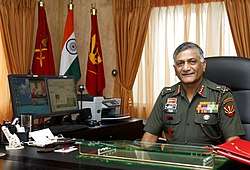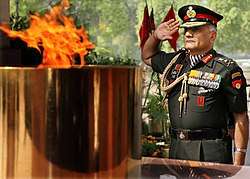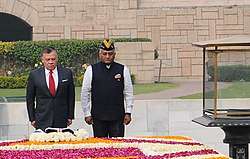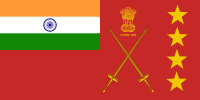V. K. Singh
General Vijay Kumar Singh, PVSM, AVSM, YSM, ADC, MP (born 10 May 1951) is an Indian politician and a former four-star General in the Indian Army. Since May 30, 2019, he is serving as the Minister of State for Road Transport and Highways in the Second Modi ministry. He previously served as Minister of State for External Affairs in the First Modi ministry and as Minister of State (Independent Charge) for Development of the North-Eastern Region.
During his military career, Singh served as the 23rd Chief of the Army Staff from 2010 to 2012. Singh took the Government of India to court in a dispute over his date of birth and subsequent retirement, becoming the first serving Indian military Chief of Staff to take legal action against the Indian government.
After his retirement from the military, Singh joined the Bharatiya Janata Party (BJP) in 2014 and was elected Member of Parliament of the Lok Sabha for the Ghaziabad constituency of Uttar Pradesh in that year's general election. He was re-elected to the same seat in 2019.
Singh has written an autobiography called Courage and Conviction.
Early life and education
Singh was born on 10 May 1951 to Captain (later Colonel) Jagat Singh, an officer then serving in the 14th battalion The Rajput Regiment of the Indian Army, and Krishna Kumari, at the Military Hospital at Pune.[1][2] He was born into the Tomar clan, with roots in the Bapora village in the Bhiwani district of Haryana. His paternal grandfather, Daffadar Mukhram Singh, served with the 3rd Cavalry. All five brothers of his father all served in the Army, either joining the 1st Horse (Skinner's Horse) or the 7th Rajput Regiment.[3] His maternal grandfather, Subedar Shimbu Singh, also served in the Army and hailed from the Bohra Kalan village in the Gurgaon district.[2]
Singh's mother was diagnosed with terminal cancer and passed away in 1952. He was raised by his maternal grandparents before his father remarried and he went to live them for a few years. At the age of 8, he joined the Birla Public School in Pilani, Rajasthan, a boarding school. He joined the National Cadet Corps during his schooling and served in all three wings.[4]
National Defence Academy
He qualified in the entrance exam and having filled 'Air Force' as his first choice, he appeared before the No. 1 Air Force Selection Board in Dehradun. He entered the National Defence Academy (NDA) in 1966.[5] A part of the 'HUNTER' squadron, he held a number of cadet appointments at the NDA. He became a Corporal in his fifth term, the battalion cadet captain (BCC) in his sixth term, and officiated as the Academy Cadet Captain (ACC) for a short while. In his fifth term, on the request of his father, he was moved from the Air Force to Army.[6]
Indian Military Academy
After graduating from the NDA, he entered the Indian Military Academy (IMA) in June 1969. He was assigned to 'Cassino' Company at the academy. He was appointed senior under officer (SUO) in his fourth term. He passed out from the IMA in 1970, placed in the top ten in the merit list.[7]
Military career
Singh was commissioned into the 2nd Battalion of the Rajput Regiment (Kali Chindi) on 14 June 1970. The battalion was among the oldest in the Indian Army, having been raised in 1798 as 1/16 Bengal Native Infantry.[8][9] He joined the battalion in Delhi, where it was garrisoned in the Red Fort and the Rashtrapathi Bhavan. He was slotted into 'C' company of the battalion.[10] He attended the Young Officers (YOs) course at the Infantry School in Mhow in November 1970. He completed the course and joined his battalion in early 1971 in Tamulpur in Assam where the battalion had moved.[11] Before the out-break of the Indo-Pakistani War of 1971, he was appointed Intelligence Officer (IO) of the battalion. The battalion moved to Meghalaya in mid-1971 and fought the war, entering East Pakistan from the east. Singh served as the IO through the war.
After the war, the battalion to Bhutan on a training exercise with the Royal Bhutan Army. In 1973, he was nominated to attend the battalion support weapons course at Mhow. After finishing the course and returning to the battalion, in early 1974, he was again sent to attend the winter warfare course at Gulmarg. In mid-1974, he was posted to the Infantry School as an instructor in the platoon weapons division.[12][13]
In late 1975, Singh was one of two officers selected to attend the United States Army Ranger School at Fort Benning, Georgia in the United States. The Ranger course is 62 days long and is aimed at small unit tactics and leadership. During this course, he was assigned to Whisky company of the 75th Ranger Regiment. He performed well in the physically-extracting course, which started with over 300 students and ended with only about 90 graduating. He was graded an honours graduate since he had graded more than 80%. [14] Since he was a graduate of the Ranger School, he was permitted to wear the coveted Ranger tab on his uniform.[15]
After completing the course, he returned to India and was posted to the Commando School at Belgaum.[12] After a year at the school, he moved back to his battalion in Secunderabad but was immediately selected to attend the Junior Command course at the College of Combat in Mhow. He finished the course and joined his battalion and was given command of a company. Two months later, he was selected to attend the winter warfare advaced course at the High Altitude Warfare School at Gulmarg.[16]
In April 1978, Singh came back to his battalion which was to move to Poonch for its operational tenure along the Line of Control. He commanded the 'A' company of the battalion during this tenure. Later that year, he was posted to the Indian Military Training Team (IMTRAT) in Bhutan. He served as an instructor at IMTRAT for about two years. After his return from Bhutan, he was transferred to a new unit, the 25th battalion of the Rajput Regiment (25 Rajput) at Fatehgarh. He was given command of the Delta company of the battalion.[16]
The battalion then moved to Alwar where Singh served as a company commander. In March 1982, he was selected to attend the Defence Services Staff College, Wellington, having secured a competitive vacancy.[17] After completing the year-long course, he was posted as General Staff Officer 2 (GSO-2) in the Military Operations (MO) Directorate at Army headquarters. His tenure at the MO directorate was an eventful one. He had a ring-side view during Operation Meghdoot in early 1984, Operation Blue Star later that year, Operation Brasstacks in late 1986 and the 1987 Sino-Indian skirmish in the Sumdorong Chu Valley.[16]
In mid-1987, he joined his battalion as a company commander. In July, as part of the 76 Infantry Brigade, the battalion moved to Chennai and embarked for Sri Lanka on the Tank Landing Ship INS Magar (L20). Inducted as part of the Indian Peace Keeping Force, they landed at Trincomalee. He spent the next two years in Sri Lanka fighting the Liberation Tigers of Tamil Eelam (LTTE). In mid-1988, he was promoted to the rank of Lieutenant Colonel and was appointed second-in-command of the battalion.[16] On 26 January 1990, he was awarded the Yudh Seva Medal for leading an operation which eliminated 6 LTTE men.[18]
In late 1989, Singh was approved to be promoted to the rank of Colonel and cleared to command a battalion. In early 1990, the battalion embarked for Mumbai. Shortly thereafter, Singh was appointed Chief Instructor of the Commando School at Belgaum, where he had earlier served as an instructor.[19][20] He was earmarked by the Colonel of the Regiment to take over command of 24 Rajput, but Singh was determined to get back to his old battalion (2 Rajput) or take over the battalion he served with in Sri Lanka (25 Rajput). After a few months, he was appointed Commanding Officer of 2 Rajput.[16] The battalion was in Nowshera, Jammu and Kashmir along the Line of Control. It was a part of the 80 Brigade under the 25th Infantry Division. He commanded the battalion for about two years in Nowshera, before taking the unit to its peace location in Faizabad. The tenure started off in a tense environment - the Demolition of the Babri Masjid in December 1992, when the battalion was on the move to Faizabad.[16]
In June 1994, Singh was selected to attend the Higher Command Course at the Army War College, Mhow. After the ten-month course, he was appointed Colonel General Staff (Col GS) of the 12th Infantry Division at Jodhpur. He spent close to three years in this appointment under two division commanders.[16] In 1998, he was promoted acting Brigadier and appointed Commander of the 168 Infantry Brigade in Samba, Jammu and Kashmir.[12][21] As Brigade commander, he had four infantry battalions and two Border Security Force units under his command. A year into his command, the Kargil War broke out and all units were on high alert. He was in command of the brigade till mid-2000.[16]
In June 2000, Singh was selected to attend the United States Army War College in Carlisle, Pennsylvania in the United States.[22] He performed well at the War College and was graded 'exceptional' in the course. After the course, he returned to India and was appointed Brigadier General Staff (BGS) of Jalandhar based XI Corps. He served in this appointment during Operation Parakram when Indian troops were mobilised on the border in the wake of the 2001 Indian Parliament attack.[16]
General Officer

Singh was promoted to the rank of Major General and appointed General Officer Commanding (GOC) Victor Force - a division-sized formation in the Rashtriya Rifles in Jammu and Kashmir. The Victor Force is responsible for the districts of Anantnag, Pulwama, Shopian, Kulgam and Budgam. For his distinguished service as GOC Victor Force, he was awarded the Ati Vishisht Seva Medal on 26 January 2003.[23] After a one-and-a-half tenure, he took over as the Chief of Staff (COS) of the XV Corps.[24] As the COS and the officiating Corps Commander, he was involved in the relief operations in the aftermath of the devastating 2005 Kashmir earthquake, the deadliest earthquake to hit South Asia since the 1935 Quetta earthquake.[25]
On 15 April 2006, Singh was promoted to the rank of Lieutenant General and shortly thereafter appointed General Officer Commanding II Corps at Ambala. He was at the helm of the Strike Corps for about two years. On 25 February 2008, he was promoted to Army Commander grade and appointed General Officer Commanding-in-Chief Eastern Command.[26] For distinguished service of the highest order, he was awarded the Param Vishisht Seva Medal on 26 January 2009.[23][27]
Chief of Army Staff

Singh became the 24th Chief of Army Staff on 31 March 2010, and was the first commando to achieve that position.[28] Towards the end of his career, a dispute regarding his date of birth arose; Singh took the Government of India to court and become the first serving officer of the Indian Army to do so.[29] Because of an error made in 1965 when he enrolled with the National Defence Academy, official records misstated the year in which he was born. Singh withdrew the writ in February 2012 when, according to The Hindu, the Supreme Court of India "refused to intervene". The Court noted there was no dispute regarding his actual date of birth and that the matter being contested was the way in which it been recorded. It ruled Singh had on three occasions accepted the misrecorded date.[30]
The BBC noted in 2012 defence experts considered a drive to modernise the Indian army had suffered from "a lack of planning and acrimony between the military and the defence ministry". This report followed an interview given by Singh in March 2012 that caused a political row. According to Singh, over a year earlier he had reported to A. K. Antony, the defence minister, that he had been offered a bribe of US$2.7 million if the army bought several hundred sub-standard vehicles. Antony issued a rebuttal to the interview, saying he had requested a written report from Singh regarding the incident and that this had never been submitted. Two days after the interview with Singh, a correspondence between V.K. Singh and the Prime Minister Manmohan Singh was leaked. The correspondence criticised the standard of India's defences and caused another political row.[31]
Singh retired as Chief of Army Staff on 31 May 2012. He was succeeded by General Bikram Singh.[32]
Political career
After his retirement from the military, Singh showed support for the anti-corruption movement.[33] He was seen on the stage in August 2012 at Ramlila Maidan in New Delhi, where the yoga instructor Ramdev was fasting in protest of alleged black money and corruption. Singh was reported to have said, "It is shocking but true that over two lakh farmers have committed suicide since 1995. The problems of farmers will have to take the forefront in this movement as the government has turned a blind eye to their woes."[34] Around that time he also said the anti-corruption movement, whose principal figurehead was Anna Hazare, to that of the Bihar Movement that was led by Jayaprakash Narayan in 1975. Singh said, "When I evaluate the country's present condition, it is similar to that of 1975. Jayaprakash Narayan had then said 'Vacate the throne, common people are coming'. He felt then that corruption is the root of all problems ... the situation in the country is the same today."[35]

Singh and Ramdev led a demonstration on 23 December 2012 at Jantar Mantar, New Delhi, on the 2012 Delhi gang rape case.[36][37] Singh joined the BJP on 1 March 2014.[38] He won the Ghaziabad (Lok Sabha constituency) seat in the 2014 Indian general election, defeating Raj Babbar of the Indian National Congress by a margin of 567,260 votes.[39] He was re-elected in a landslide during the 2019 Indian general election.
Union minister
In May 2014, Singh was appointed as Minister of State of External Affairs and Minister of state (independent charge) for North East Region in the NDA-led Indian government.[40] He was relieved of responsibility for the North East Region in November 2014, when Jitendra Singh replaced him.[41]
Singh is praised for leading Operation Raahat, a rescue mission to evacuate Indian citizens and other foreign nationals from Yemen during 2015 Yemeni Crisis.[42] Prime Minister Narendra Modi in April 2015 said, “I believe this is the first time in the world that a government minister has stood on the battlefield like a soldier to do this work ... I salute General V. K. Singh.”[43] In May 2019, Singh became Minister of State for Road Transport and Highways.[44]
Honours and awards
Military awards
During his service as the COAS, Singh was appointed Honorary Aide-De-Camp to the President of India. He served as the Colonel of the Rajput Regiment and as the Honorary Colonel of the Brigade of Guards, by virtue of being the Army Chief.[45] On 11 March 2011, he was inducted into the United States Army War College Class of 2001 graduates International Fellows Hall of Fame. He is the 33rd International Fellow and the first officer from the Indian Armed Forces to be inducted.[46]
Dates of rank
| Insignia | Rank | Component | Date of rank |
|---|---|---|---|
| Second Lieutenant | Indian Army | 14 June 1970[8] | |
| Lieutenant | Indian Army | 14 June 1972[47] | |
| Captain | Indian Army | 14 June 1976[48] | |
| Major | Indian Army | 14 June 1983 | |
| Lieutenant-Colonel | Indian Army | 1 November 1991[49] | |
| Colonel | Indian Army | 1 February 1993[50] | |
| Brigadier | Indian Army | 4 June 1999[51] | |
| Major General | Indian Army | 29 June 2004[52] | |
| Lieutenant-General | Indian Army | 1 October 2006[53] | |
| General (COAS) | Indian Army | 1 April 2010[54] | |
Notes
Citations
- "Members : Lok Sabha". 164.100.47.194.
- Singh & Verma 2013, p. 17.
- Singh & Verma 2013, p. 15.
- Singh & Verma 2013, p. 18-21.
- Mohan, Raman (24 January 2010). "Bapoda village basks in Gen VK Singh's glory". The Tribune. Chandigarh. Retrieved 3 April 2010.
- Singh & Verma 2013, p. 29.
- Singh & Verma 2013, p. 29-33.
- "Part I-Section 4: Ministry of Defence (Army Branch)". The Gazette of India. 16 October 1971. p. 1209.
- Dutta, Sujan (30 July 2011). "Generation shift in air force". The Telegraph. Retrieved 26 March 2012.
- Singh & Verma 2013, p. 36-37.
- Singh & Verma 2013, p. 43-47.
- "Change of Guard - General VK Singh new COAS". Sainik Samachar. 10 April 2010. Retrieved 15 June 2014.
- Singh & Verma 2013, p. 85-89.
- Singh & Verma 2013, p. 94-101.
- "AR 670-1" (PDF). Archived from the original (PDF) on 6 February 2012.
- Singh & Verma 2013.
- "SELECTION FOR THE 39th DEFENCE SERVICES STAFF COLLEGE COURSE" (PDF). pibarchive.nic.in. 31 March 1982.
- "GALLANTRY AND DISTINGUISHED SERVICE AWARDS FOR DEFENCE PERSONNEL" (PDF). pibarchive.nic.in. 24 January 1990.
- "Did you know: Gen VK Singh is a small time movie star!". First Post. 23 January 2012. Retrieved 15 June 2014.
- "When the army chief did a cameo in Bollywood". India Today. 3 April 2010. Retrieved 15 June 2014.
- "Gen V K Singh takes over as Army Chief". India Strategic. 31 March 2010. Retrieved 15 June 2014.
- "Gen VK Singh battles odds, becomes 26th army chief". DNA. 31 March 2010. Retrieved 26 March 2012.
- "Gen. V.K. Singh is new Chief of the Army Staff". The Hindu. 1 April 2010.
- Singh & Verma 2013, p. 251-256.
- "The great Quetta tragedy". DAWN Newspaper. 25 October 2008.
- "Senior Appointments : Army". pib.gov.in. 25 February 2008.
- "Republic Day Gallantry and other Defence Decorations". pib.gov.in. 25 January 2009.
- "Gen V K Singh takes over as Army Chief". India Strategic. March 2010. Retrieved 27 May 2014.
- Gokhale, Nitin A. (26 March 2012). "Details of who allegedly offered Rs. 14-crore bribe to Army chief". NDTV. Retrieved 26 March 2012.
- Venkatesan, J. (10 February 2012). "Army Chief loses age war". The Hindu. Retrieved 11 February 2012.
- "India's corruption scandals". BBC.
- "Gen. V.K. Singh to retire today". =The Hindu. 31 May 2012. Retrieved 31 May 2012.
- "V.K. Singh: throw the corrupt out of power". 4 August 2012.
- Ali, Mohammad (13 August 2014). "Ramdev takes on Congress, warns of march to Parliament". The Hindu.
- "VK Singh now battles with Baba Ramdev". Zee News. ANI. 12 August 2012.
- "V K Singh, Baba Ramdev named in FIR for violence at Jantar Mantar". Financial Express. PTI. 24 December 2012.
- "V K Singh, Ramdev named in FIR for violence at Jantar Mantar". Times of India. 24 December 2012.
- "Former Army Chief Gen. V K Singh joins BJP along with other Officers". Bihar Prabha. IANS. 1 March 2014. Retrieved 1 March 2014.
- Sinha, Arunav (16 May 2014). "Former chief of Army staff General (retired) VK Singh defeats Raj Babbar of Congress by 567260 votes to register a win at Ghaziabad". The Times of India. TNN. Archived from the original on 15 January 2017. Retrieved 15 January 2017.
- "List of ministers in Narendra Modi's government". Economic Times. 27 May 2014. Retrieved 7 June 2014.
- Sharma, Aman (11 November 2014). "What went wrong? VK Singh lost Doner to MoS for personnel Jitendra Singh". Economic Times. Retrieved 21 April 2015.
- "India begins evacuating citizens". The Hindu. 31 March 2015. Retrieved 31 March 2015.
- "Presstitutes remark row: PM Narendra Modi says media ignoring V K Singh's good work in Yemen". Indian Express. 19 April 2015. Retrieved 20 April 2015.
- "PM Modi allocates portfolios. Full list of new ministers", Live Mint, 31 May 2019
- "h3". www.sainiksamachar.nic.in.
- "V. K. Singh: the veteran of wars who lost the age battle". Daily Bhaskar. 26 March 2012. Retrieved 26 March 2012.
- "Part I-Section 4: Ministry of Defence (Army Branch)". The Gazette of India. 9 September 1972. p. 1313.
- "Part I-Section 4: Ministry of Defence (Army Branch)". The Gazette of India. 4 December 1976. p. 1662.
- "Part I-Section 4: Ministry of Defence (Army Branch)". The Gazette of India. 6 March 1993. p. 379.
- "Part I-Section 4: Ministry of Defence (Army Branch)". The Gazette of India. 14 May 1994. p. 939.
- "Part I-Section 4: Ministry of Defence (Army Branch)". The Gazette of India. 3 January 2004. p. 20.
- "Part I-Section 4: Ministry of Defence (Army Branch)". The Gazette of India. 2 September 2006. p. 1208.
- "Part I-Section 4: Ministry of Defence (Army Branch)". The Gazette of India. 7 April 2007. p. 567.
- "Part I-Section 4: Ministry of Defence (Army Branch)". The Gazette of India. 28 August 2010. p. 1492.
References
- Singh, V.K.; Verma, Shiv Kunal (2013), Courage and Conviction: An Autobiography, Aleph Book Company, ISBN 978-9382277576
External links
- General V. K. Singh, PVSM, AVSM, YSM, ADC in the Indian Army official website
| Military offices | ||
|---|---|---|
| Preceded by K D S Shekhawat |
General Officer Commanding II Corps 2006-2008 |
Succeeded by J P Singh |
| Preceded by K S Jamwal |
General Officer Commanding-in-Chief Eastern Command 2008-2010 |
Succeeded by Bikram Singh |
| Preceded by Deepak Kapoor |
Chief of Army Staff 2010-2012 |
Succeeded by Bikram Singh |
| Lok Sabha | ||
| Preceded by Rajnath Singh |
Member of Parliament for Ghaziabad 2014 – Present |
Incumbent |
| Political offices | ||
| Preceded by Mansukh L. Mandaviya |
Minister of State for Road Transport and Highways 2019-present |
Succeeded by Incumbent |
| Preceded by |
Minister of State for External Affairs 2014-2019 |
Succeeded by V. Muraleedharan |
| Preceded by Paban Singh Ghatowar Minister of State with Independent Charge |
Minister of Development of North Eastern Region 26 May 2014 – 9 November 2014 Minister of State with Independent Charge |
Succeeded by Jitendra Singh Minister of State with Independent Charge |
| Preceded by Rao Inderjit Singh (Minister of State with Independent charge) |
Minister of Statistics and Programme Implementation (Minister of State with Independent charge) 10 November 2014 – 5 July 2016 |
Succeeded by D. V. Sadananda Gowda |

